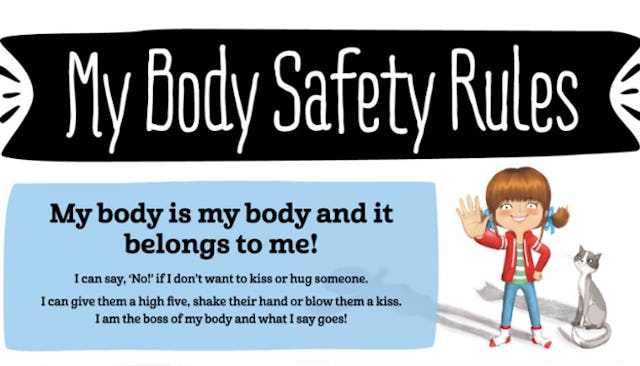This Simple Poster Can Help Protect Kids From Sexual Abuse

These tips are crucial in educating our kids and keeping them safe
No parent wants to think of their child as the victim of sexual abuse, and it’s for that very reason that it needs to be discussed. Educating our kids about their bodies and who’s allowed to touch them is a must if we want to keep them safe. And this poster about body safety is the perfect tool to accompany these conversations.
Educate 2 Empower provides this poster and many others for free in order to help parents and educators keep kids safe from abuse.
Image via E2E
The poster uses simple language and guidelines to assist kids in identifying potentially abusive behavior. The first rule listed is, “My body is my body and it belongs to me,” which reminds a child that they can always say no to physical affection from anyone, instead, offering a high five, a handshake or to blow the person a kiss. Teaching a child they’re the boss of their body is the first step in protecting them from becoming a victim of abuse.
It advises kids to have a “safety network” of five people they can always trust if they feel worried or scared. It gives words to the “early warning signs” that someone may be trying to hurt them, explaining that they should tell someone in their safety network if they experience symptoms of being frightened, such as sweating, a fast heartbeat or a stomach ache.
The poster reminds kids they don’t have to keep secrets that make them uncomfortable and that they should turn to the trusted adults in their safety network if that’s the case. This is an important lesson, as we sometimes discourage children from tattling or telling a fun secret, like a surprise party for grandma or the arrival of a new brother or sister, and they need to understand the difference. In a piece for The Huffington Post, author Jayneen Sanders suggests telling your kids that in your family, there are “happy surprises,” not secrets, and happy surprises are always eventually told. This way, a child understands that it’s wrong when someone tells them to keep a secret that sets off alarm bells.
The last (and possibly most important) rule from the poster is helping kids understand what body parts are private (the poster says anything covered by a bathing suit) and to always use the proper names to identify those parts. It reinforces that no one can touch their private parts and that no one should ask them to touch theirs either, or show them pictures of private parts. Of course, it tells children to turn to their safety network if the unthinkable were to happen.
This isn’t a comfortable subject by any means, and for that reason, some parents shy away from it. It can be overwhelming and upsetting trying to help our kids learn to prevent abuse, but this poster goes a long way in guiding parents toward teaching their children how to keep themselves safe.
You can download the poster here.